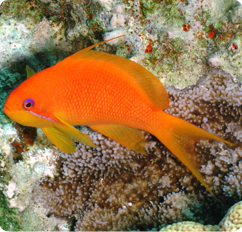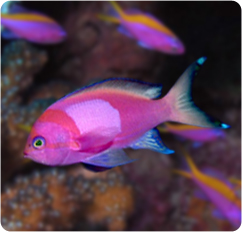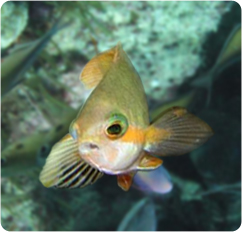|
Genus Pseudanthias - Anthias
The False Anthias is THE Real Anthias  How would you like a fancy sea bass for your aquarium? These small, colorful fishes are ubiquitous on tropical reefs around the world, where they often form huge, brightly-colored shoals that constantly shift back and forth across a tapestry of dazzling coral. In many ways, these fishes define the phrase “reef fish.” In the aquarium, fancy sea basses are capable of bringing an artificial reef to life more readily than almost any other group of fishes. Their colors are often vivid and their movements are captivatingly graceful. How would you like a fancy sea bass for your aquarium? These small, colorful fishes are ubiquitous on tropical reefs around the world, where they often form huge, brightly-colored shoals that constantly shift back and forth across a tapestry of dazzling coral. In many ways, these fishes define the phrase “reef fish.” In the aquarium, fancy sea basses are capable of bringing an artificial reef to life more readily than almost any other group of fishes. Their colors are often vivid and their movements are captivatingly graceful.
Unfortunately, the fancy sea basses are also considered difficult-to-keep, delicate and expert-only animals, and this fact keeps many aquarists from keeping them. The good news is that these beautiful reef fishes truly needn’t be expert-only fishes if the aquarist understands (and is prepared to meet) their very specific husbandry needs. That’s what this article is all about.
Fancy Sea Basses from the Subfamily Anthiinae
Are you scratching your head thinking that you’ve never heard of fancy basses before? Perhaps you know the fishes of which we are speaking by their other common name—anthias. Ah…anthias! Now that’s a fish about which you certainly have heard something. Fancy sea basses are Serranids (from the Family Serranidae) and are members of the Subfamily Anthiinae, which (according to the Integrated Taxonomic Information System or ITIS) includes twenty-five genera. Only a few of these genera are seen with any frequency in the marine aquarium hobby. They include:
- Anthias
- Hemanthias
- Holanthias
- Luzonichthys
- Nemanthias
- Plectranthias
- Pseudanthias
- Serranocirrhitus
While all of the species within these genera may be called anthias, many aquarists are only thinking of species belonging to the genus Pseudanthias when they say anthias. The fishes within this genus are the ones we also commonly call fairy basses (or basslets), and they are the real focus of this article.
Difficult to Keep?
 The reason most anthias species are considered difficult to keep in a home aquarium is because they are very active fishes that happen to be extremely competitive. Many aquarists long to keep anthias because they are such active shoaling fishes, but the downside to all this alluring activity is the fact that anthias need to feed frequently. In the wild, anthias feed near-constantly on zooplankton, which is in abundant supply in the fishes’ natural habitat. In the aquarium, however, where populations of copepods, fish eggs, larva, and other zooplankton are limited, the aquarist must meet the fishes’ needs by feeding three or more times per day. This is a husbandry requirement that many casual aquarists are not prepared to meet. The reason most anthias species are considered difficult to keep in a home aquarium is because they are very active fishes that happen to be extremely competitive. Many aquarists long to keep anthias because they are such active shoaling fishes, but the downside to all this alluring activity is the fact that anthias need to feed frequently. In the wild, anthias feed near-constantly on zooplankton, which is in abundant supply in the fishes’ natural habitat. In the aquarium, however, where populations of copepods, fish eggs, larva, and other zooplankton are limited, the aquarist must meet the fishes’ needs by feeding three or more times per day. This is a husbandry requirement that many casual aquarists are not prepared to meet.
In addition to the challenges of feeding anthias, most species are highly competitive fishes that can exhibit undue aggression in the captive environment. The reason for this is that all the common anthias species in the marine aquarium hobby are protogynous hermaphrodites which establish complex social rankings. The resulting pecking order, not to mention the aggression exhibited by individuals as they establish their place in the pecking order, can make keeping a shoal of anthias difficult unless the aquarist understands the behavior and plans accordingly.
In addition to their feeding requirements and innate aggressive tendencies, anthias are prone to both bacterial and protozoan infections. For this reason, it is absolutely essential to provide as stress-free an environment as possible for these fishes, as stress can trigger outbreaks of disease and infection.
 As you can see, anthias are not the easiest fishes to keep. In general, they have very specific feeding requirements, aggressive behavioral traits and a high susceptibility to disease and infection when stressed. Why then would anyone choose to keep them? The answer to this question is easy—anthias are beautiful, interesting fishes that, when properly understood and provided for, can be kept with success by most dedicated marine aquarists.
As you can see, anthias are not the easiest fishes to keep. In general, they have very specific feeding requirements, aggressive behavioral traits and a high susceptibility to disease and infection when stressed. Why then would anyone choose to keep them? The answer to this question is easy—anthias are beautiful, interesting fishes that, when properly understood and provided for, can be kept with success by most dedicated marine aquarists.
The False Anthias is the Real Anthias in the Saltwater Aquarium Hobby
 The genus Pseudanthias is the most well-represented genus in the marine aquarium hobby. There are perhaps more than 50 species in the genus (ITIS), and all are indigenous to the Indo-Pacific. Popular species in the hobby include the Bartlett’s anthias (P. bartlettorum), the bicolor anthias (P. bicolor), the dispar anthias (P. dispar), the Evan’s anthias (P. evansi), the lyretail anthias (P. squamipinnis), the one-stripe anthias (P. fasciatus), the purple queen anthias (P. tuka), the Randall’s anthias (P. randalli), the square anthias (P. pleurotaenia) [male pictured here -ed.], the Hutchii anthias (p. huchtii), the tri-color anthias (P. rubrizonatus), and the yellowlined anthias (P. luzonensis). The genus Pseudanthias is the most well-represented genus in the marine aquarium hobby. There are perhaps more than 50 species in the genus (ITIS), and all are indigenous to the Indo-Pacific. Popular species in the hobby include the Bartlett’s anthias (P. bartlettorum), the bicolor anthias (P. bicolor), the dispar anthias (P. dispar), the Evan’s anthias (P. evansi), the lyretail anthias (P. squamipinnis), the one-stripe anthias (P. fasciatus), the purple queen anthias (P. tuka), the Randall’s anthias (P. randalli), the square anthias (P. pleurotaenia) [male pictured here -ed.], the Hutchii anthias (p. huchtii), the tri-color anthias (P. rubrizonatus), and the yellowlined anthias (P. luzonensis).
Most fishes from the genus Pseudanthias are sexually dichromatic and dimorphic, meaning that males and females look different. This is important, because successfully putting together a shoal of these fishes requires there to be the correct ratio of males to females. In almost all cases, this means including one male anthias with two or more female anthias. Scott Michael, in his book Reef Fishes, vol. 1., recommends that one anthias be housed per 3,800 cm2 (600 in.2) of tank surface area. “In more approximate terms,” Michael’s says, “this means just one anthias per 40 to 50 gallons in a system housing other community fishes.”
Some aquarists, using a technique commonly employed in freshwater, successfully house a higher density of anthias in a home aquarium by overcrowding with females only. This approach is only recommended for advanced aquarists, however, and will not be discussed here.
Three Subgenera of Pseudanthias
The genus Pseudanthias may be broken down into three subgenera. They are:
- Franzia
- Mirolabrichthys
- Pseudanthias
Thinking of anthias as grouped in these three subgenera may help the marine aquarist better understand how to provide for the specific anthias species he or she is considering. For example, species within the subgenus Mirolabrichthys are, generally speaking, less aggressive than species from the other two subgenera. As such, these anthias may be better suited for a small group than anthias from the subgenus Franzi or Pseudanthias. Anthias species commonly grouped in the subgenus Mirolabrichthysinclude:
 It should be noted, however, that even some species within the subgenus, Mirolabrichthys are considered more aggressive than others. For example, the Bartlett’s anthias (P. bartlettorum) is generally considered more aggressive than the dispar anthias (P. dispar), although the advanced aquarist can certainly have success with small shoals of both species in a home aquarium. Likewise, some species from the subgenus Pseudanthias may be surprisingly less belligerent (e.g., P. randalli and P. ventralis). There are only two species of anthias included in the subgenus Franzia. They are P. huchtii [pictured here -ed.] and P. squamipinnis. All the other species are included in the subgenus Pseudanthias. It should be noted, however, that even some species within the subgenus, Mirolabrichthys are considered more aggressive than others. For example, the Bartlett’s anthias (P. bartlettorum) is generally considered more aggressive than the dispar anthias (P. dispar), although the advanced aquarist can certainly have success with small shoals of both species in a home aquarium. Likewise, some species from the subgenus Pseudanthias may be surprisingly less belligerent (e.g., P. randalli and P. ventralis). There are only two species of anthias included in the subgenus Franzia. They are P. huchtii [pictured here -ed.] and P. squamipinnis. All the other species are included in the subgenus Pseudanthias.
In general, it is best to not mix species of anthias in most home aquaria, as aggressive behavior may not be limited to conspecifics.
Keys to Success with Anthias
Anthias do best in a large aquarium with plenty of life rock. Most anthias are found in high flow areas in the wild, and they appreciate the same in captivity. Because anthias require more feeding than many other species of marine aquarium fishes, it is generally advisable to provide hefty filtration including an excellent protein skimmer. Keeping the water quality high and stable will go a long way to reducing stress. Any aquarium housing anthias should be covered, as many species are known jumpers.
Anthias should only be housed with other peaceful community fishes. Generally considered reef compatible, anthias will leave all sessile invertebrates alone, although they may be harmed by larger invertebrates such as some anemones (e.g., carpet anemones (Stichodactyla spp.), corkscrew anemones (Macrodactyla doreensis)).
Perhaps the single most important thing the saltwater aquarist can do for his or her anthias is to provide them with a refugium. A refugium is essentially a refuge in the form of a separate tank plumbed to the display tank. The refugium houses organisms that might otherwise be consumed in a reef tank. Most importantly, a refugium can promote healthy populations of zooplankton that will then make their way into the display tank providing a source of food for the anthias. Designing, setting-up, stocking, and maintaining a refugium is beyond the scope of this article, but suffice it to say that the use of a refugium is a definite benefit in any system housing anthias.
Even without a refugium, many anthias can be successfully kept if provided a diet of small meaty foods at least three times per day. Frozen mysid shrimp are appreciated and should be offered. Most anthias will also readily accept commercially prepared foods.
Conclusion
 Fancy sea basses have an awful lot going for them as marine aquarium fishes, but they do have specific husbandry requirements. If the aquarist understands theses fishes’ biology and behavior, he or she can have spectacular success keeping a small shoal in a home aquarium. While a shoal of anthias can be a stunning sight, it is also worth re-iterating some sound advice from Scott Michael. To wit: “A single healthy and long-lived anthias is always better than a group that quickly self-destructs.” Fancy sea basses have an awful lot going for them as marine aquarium fishes, but they do have specific husbandry requirements. If the aquarist understands theses fishes’ biology and behavior, he or she can have spectacular success keeping a small shoal in a home aquarium. While a shoal of anthias can be a stunning sight, it is also worth re-iterating some sound advice from Scott Michael. To wit: “A single healthy and long-lived anthias is always better than a group that quickly self-destructs.”
Whether you attempt a shoal or a single individual, successfully keeping anthias can be one of the most rewarding aspects of the marine aquarium hobby.
|